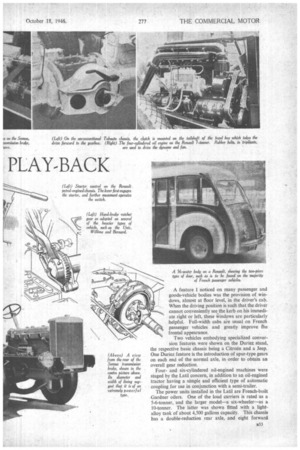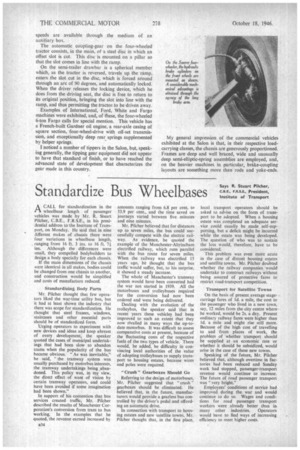PARIS SHO PLAY-BACK
Page 38

Page 39

Page 40

If you've noticed an error in this article please click here to report it so we can fix it.
By P. G. TUCKER
CONTINUING my observations on the exhibits at the Paris Salon, which closed its doors on Sunday last, the most unconventional chassis layout was probably that adopted on the Tubauto, of which two examples of complete machines were shown in the form of 12-seater and 38-seater vehicles. The Tubauto is powered by two four-cylindered petrol engines, each developing 55 b.h.p., mounted transversely behind the rear axle. There is a centrally disposed bevel box, from which the drive is taken forward to the gearbox and rear axle. The position chosen for the clutch is at the rear of the bevel box.
In styling and general external finish, French passenger vehicles are particularly attractive, but, judged by our own standards, interior finish and appointment are, in most cases, somewhat utilitarian.
The 12-seater Tubauto is, obviously, a special-purpose machine, as it is fitted with a single bed, a seat for an attendant, and a lavatory, and special attention has been directed towards providing efficient ventilation. As in the majority of French passenger vehicles, the doors are divided and hinged in the centre. A feature I noticed on many passenger and goods-vehicle bodies was the provision of windows, almost at floor level, in the driver's cab. When the driving position is such that the driver cannot conveniently see the kerb on his immediate right or left, these Windows are particularly helpful. Full-width cabs are usual on French passenger vehicles and greatly improve the frontal appearance.
Two vehicles embodying specialized conversion features were shown on the Duriez stand, the respective basic chassis being a Citroen and a Jeep. One Duriez feature is the introduction of spur-type gears on each end of the normal axle, in order to obtain an overall gear reduction.
Fourand six-cylindered oil-engined machines were staged by the Latil concern, in addition to an oil-engined tractor having a simple and efficient type of automatic coupling for use in conjunction with a semitrailer.
The power units installed in the 1Latil are French-built Gardner oilers. One of the load carriers is rated as a 5-6-tonner, and the larger model—a six-wheeler—as a 10-tonner. The latter was shown fitted with a lightalloy tank of about 4,500 gallons capacity. This chassis has a double-reduction rear axle, and eight forward
speeds are available through the medium of an auxiliary box.
The automatic coupling-gear on the four-wheeled tractor consists, in the main, of a steel disc in which an offset slot is cut. This disc is mounted on a pillar so that the slot comes in line with the ramp.
On the semi-trailer drawbar is a spherical member which, as the tractor is reversed, travels up the ramp, enters the slot cut in the disc, which is forced around through an arc of 90 degrees, and automatically locked. When the driver releases the locking device, which he does from the driving seat, the disc is free to return to its original position, bringing the slot into line with the ramp, and thus permitting the tractor to be driven away.
Examples of International, Ford, White and Fargo machines were exhibited, and, of these, the four-wheeled 6-ton Fargo calls for special mention. This vehicle has a French-built Gardner oil engine, a rear-axle casing of square section, four-wheel-drive with off-set transmission, and exceptionally deep rear springs supplemented by helper springs.
I noticed a number of tippers in the Salon, but, speaking generally, the tipping gear equipment did not appear to have that standard of finish, or to have reached the advanced state of development that characterizes the gear made in this country. My general impression of the commercial vehicles exhibited at the Salon is that, in their respective loadcarrying classes, the chassis are generously proportioned. Frames are deep and well braced, wide and unusually deep semi-elliptic-spring assemblies are employed, and, on the heavier machines in particular, brake-coupling layouts are something more than rods and yoke-ends.












































































